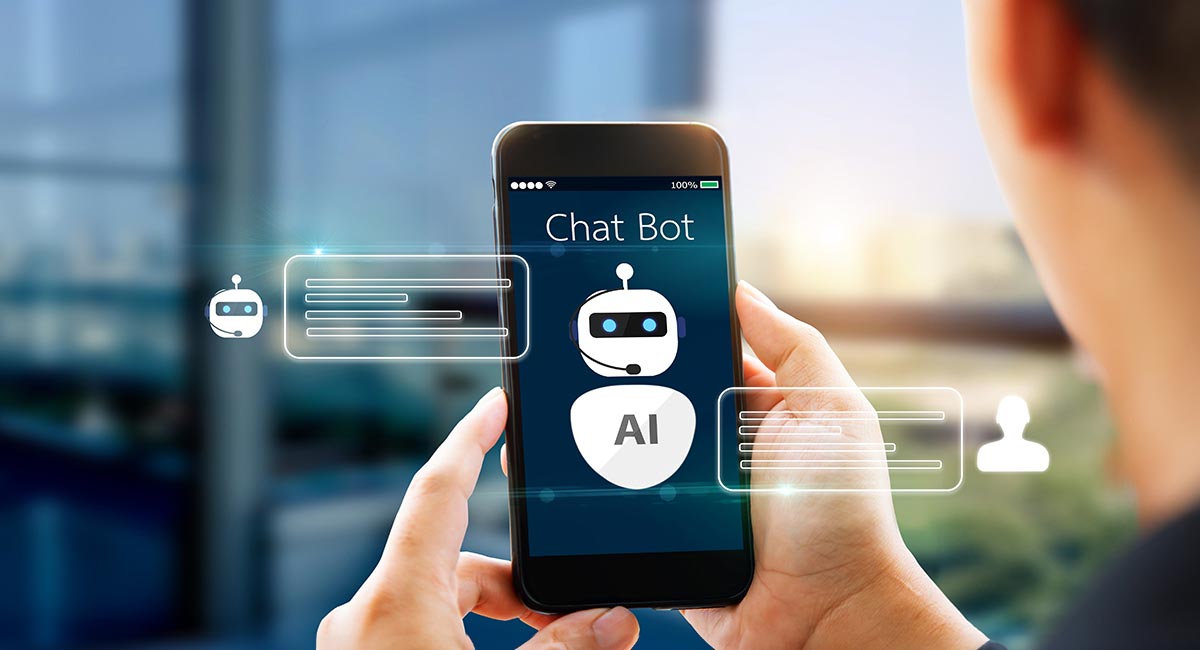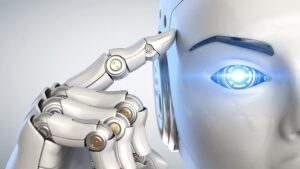Artificial intelligence has generated plenty of buzz over the last few years. When AI’s supporters extol the virtues and uses of artificial intelligence, they invariably mention chatbots. So, what is an AI chatbot, anyway? How do they work? Why do we have them? What good are they?
This article explores the world of AI-enabled chatbots. We’ll answer the above questions and plenty more, then present you with an opportunity to learn more about gaining skills through online AI and machine learning training.
Let’s begin with the question, “What is an AI chatbot?”
What is an AI Chatbot?
Chatbots are computer programs that simulate and process human conversation (both written and spoken), letting people interact with digital devices like they were communicating with a living person. Chatbots come in many forms, from rudimentary programs that reply to a simple query with a single-line response to sophisticated digital assistants that can learn and evolve to deliver greater levels of personalization the more they gather and process information.
An AI chatbot is a software program that uses Natural Language Processing (or NLP for short) to comprehend written or spoken language, detect the asker’s intent, and deliver the optimal response.
Do All Chatbots Use AI?
Not all chatbots use AI. In fact, chatbots predate artificial intelligence. Rule-based chatbots provide stock responses to questions based on specific pre-determined keywords. So, for example, a rule-based chatbot for a credit card company may have “late fees” as a keyword, so when a customer logs in and asks, “Why do I have a late fee charged to my account?” the rule-based chatbot will respond with text prepared in advance because it “reads” the phrase “late fees.”
Let’s further explore the differences between the two primary chatbot forms.
Rule-based Chatbots vs. AI Chatbots
Rule-based chatbots, or task-oriented or declarative chatbots, are single-purpose programs that perform a single function and are currently the most used chatbots. Using a set of rules, some NLP, and very little ML, rule-based chatbots generate automated but conversational answers to customer inquiries. These chatbot interactions are particular and structured. Most of these chatbots are found in and are support and service functions and are little more than FAQs on steroids. Task-oriented chatbots typically handle common questions (e.g., business hours or simple transactions with few variables). Though they use enough NLP so end users can interact with them conversationally, their capabilities are relatively basic.
On the other hand, AI-powered chatbots, also called data-driven and predictive (conversational) chatbots, are often called virtual or digital assistants. These chatbots are considerably more sophisticated, interactive, and personalized than their task-oriented counterparts. They are contextually aware, leveraging natural-language understanding (NLU), machine learning (ML), and NLP to learn as they go. Chatbots fueled by AI use predictive intelligence and analytics to promote personalization based on user profiles and past behavior. Also, digital assistants can understand the user’s preferences over time, offer recommendations, and even anticipate needs. AI-based chatbots can also initiate conversations and monitor data and intent. Amazon’s Alexa and Apple’s Siri are examples of data-driven, consumer-oriented, predictive chatbots.
Why Were Chatbots Created in the First Place?
Businesses wanted something more personal than user guides or FAQ lists to provide customers with requested information. Chatbots are a great way to handle customer queries or complaints without hiring extra personnel to handle these requests. Thus, a company can offer a more personalized experience by investing in a chatbot without paying extra. It’s a wise investment.
How Does an AI Chatbot Work?
Here are the steps comprising chatbot functionality:
- The user inputs their question
- The chatbot program analyses the request
- The chatbot program identifies intent, tone, sentiment, and entities
- The program composes a reply and sends it to the user
So, if you want to introduce an AI-empowered chatbot into your customer service plans, use the following steps.
- Define your needs. What do you want the chatbot to accomplish? How will it be used?
- Shop around for an application. After you quantify your need, shop for the right chatbot for your organization. There are plenty of chatbots to choose from.
- Integrate it with your customer communication channel. These channels include SMS, Google RCS, WhatsApp, Web Chat, and Facebook Messenger.
- Test the chatbot and adjust accordingly. Test the chatbot and adapt accordingly. Place your new chatbot on a local server, run through some use test cases with colleagues and friends, and see how it works. Give it a test run, then tweak the application until it fits your mold.
Are Artificial Intelligence Chatbots Pre-trained?
AI chatbots do require a level of pre-training. Programmers must subject them to a training period to teach the program how to understand the context of the customer’s comments, and this understanding requires access to reams of conversational data. This data is the “textbook” in the chatbot’s “education.”
Fortunately, many AI-based chatbot applications come pre-trained. Programmers can then adjust these applications, customizing them based on the business’s particular needs, adding practical examples, and creating additional topics.
The Benefits of AI Chatbots
AI-powered chatbots bring many advantages to businesses. Their primary benefits are:
- Adaptability. AI-generated chatbots can be adjusted to serve a variety of uses, whether it’s for HR support, customer service, lead generation, or sales assistance. Also, the bot can adapt to the customer’s needs.
- Affordability. The cost of implementing and running an artificial intelligence-powered chatbot is low compared to employing extra human personnel.
- Availability. It’s much easier for a company to provide 24/7 availability when it employs an AI bot instead of a human agent. Whenever the consumer has an inquiry, regardless of the time or day, a chatbot is always there and ready to respond instantly. Whereas a scripted chatbot can only follow a pre-generated script, AI chatbots, based on integrated systems and databases, can give customers the same attentive, effective service as a human representative.
- Efficiency. AI-enabled chatbots allow businesses to simultaneously engage with thousands, even millions of customers at a far lesser cost and resource expenditure.
- Improving the customer’s experience. AI chatbots can noticeably enhance the customer experience by collecting additional data. By encouraging more interactions, AI-powered chatbots can streamline the customer’s journey, delivering real-time personalization and letting companies collect actionable data that can then be used to improve the business’s goods and services. If the customer has access to a well-set-up, advanced AI-powered bot, they can accomplish their entire customer journey solely through the aid of the chatbot.
So, Should You Use an AI Chatbot or a Rule-based Chatbot?
Your ultimate choice of chatbot category depends on factors such as the size of your business, the target clientele, and the extent of services and capabilities you want from the chatbot. Like any other product, you get what you pay for, so a self-teaching AI chatbot application will ultimately cost more than a simple rule-based chatbot.
Either chatbot type has its place in today’s commercial world. Once you decide what role the chatbot will play in your customer relations, you’ll be better positioned to make an informed decision.
How to Learn More About Artificial Intelligence and Machine Learning
AI chatbots are getting increasingly popular, and artificial intelligence and machine learning figure heavily in their operation. If you want to work with chatbots, consider signing up for this AI and Machine Learning bootcamp.
Learn valuable AI and ML skills through this high-engagement, comprehensive online bootcamp and equip yourself to tackle the demands and challenges of this fast-growing field. According to the Glassdoor.com website, AI engineers can earn a yearly average of $128,044. Sign up for this valuable online AI/ML course and expand your knowledge in one of today’s most exciting fields.
FAQs
Q: What is an AI chatbot used for?
A: AI chatbots are used for:
- Automating repetitive tasks
- Collecting user data and building e-mail lists
- Identifying qualified leads
- IT service management (ITSM)
- Making appointments and reservations, ordering tickets, service and price comparisons
- Providing exceptional customer service
- Upselling and cross-selling goods and services
Q: What are examples of chatbots that leverage AI?
A: Chatbot examples include:
- Siri
- Alexa
- Replika
- Globe Telecom
- Insomnobot 3000
- Meena
- BlenderBot
Q: What is the difference between a chatbot and an AI chatbot?
A: Chatbots are scripted computer programs that send pre-written replies based on keywords found in the customer’s question, whereas an AI-enabled chatbot is a more sophisticated form of chatbot that has contextual awareness and learns from the conversation.
Q: Is Alexa a chatbot?
A: As of 2020, Alexa is officially a chatbot, as Amazon expanded the ability to talk with Alexa via typed messages. In September 2023, Amazon announced it was incorporating new generative AI-powered user experiences with Alexa, which includes an AI chatbot platform.
Q: What should I look for in a chatbot?
A: Look for the following characteristics:
- A/B testing feature
- Accuracy
- Automation grade
- Branding options
- Chat routing
- Customer support
- Integrations
- Reporting and analytics capabilities
- Targeting options
- User-friendliness






